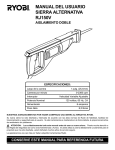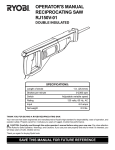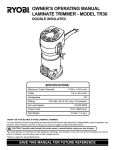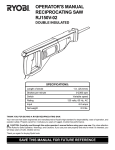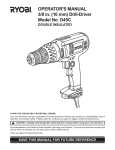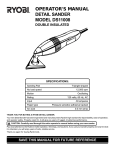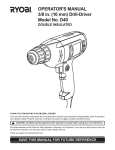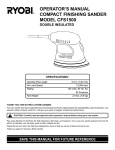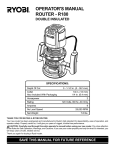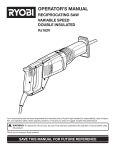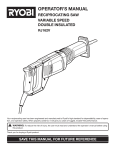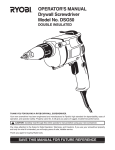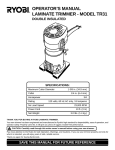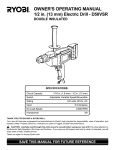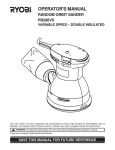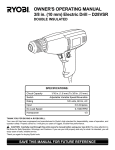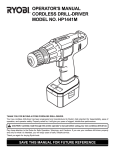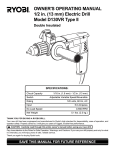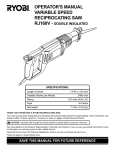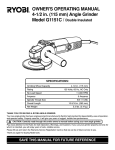Download Ryobi RJ150V Specifications
Transcript
OWNER'S OPERATING MANUAL RECIPROCATING SAW RJ150V DOUBLE INSULATED SPECIFICATIONS: Length of stroke Strokes per minute 1 in. (25.4mm) 0-2300 spm Switch Adjustable variable speed Rating 120 volts, 60 Hz, AC Input Net weight 6.0 amps 6.5 lbs. THANK YOU FOR BUYING A RYOBI RECIPROCATING SAW. Your new saw has been engineered and manufactured to Ryobi's high standard for dependability, ease of operation, and operator safety. Properly cared for, it will give you years of rugged, trouble-free performance. CAUTION: Carefully read through this entire owner's manual before using your new saw. Pay close attention to the Rules for Safe Operation, Warnings, and Cautions. If you use your saw properly and only for what it is intended, you will enjoy years of safe, reliable service. Thank you again for buying Ryobi tools. SAVE THIS MANUAL FOR FUTURE REFERENCE RULES FOR SAFE OPERATION THE PURPOSE OF SAFETY SYMBOLS IS TO ATTRACT YOUR ATTENTION TO POSSIBLE DANGERS. THE SAFETY SYMBOLS, AND THE EXPLANATIONS WITH THEM, DESERVE YOUR CAREFUL ATTENTION AND UNDERSTANDING. THE SAFETY WARNINGS DO NOT BY THEMSELVES ELIMINATE ANY DANGER. THE INSTRUCTIONS OR WARNINGS THEY GIVE ARE NOT SUBSTITUTES FOR PROPER ACCIDENT PREVENTION MEASURES. SYMBOL MEANING SAFETY ALERT SYMBOL: Indicates caution or warning. May be used in conjunction with other symbols or pictographs. WARNING: Failure to obey a safety warning can result in serious injury to yourself or to others. Always follow the safety precautions to reduce the risk of fire, electric shock and personal injury. CAUTION: Failure to obey a safety warning may result in property damage or personal injury to yourself or to others. Always follow the safety precautions to reduce the risk of fire, electric shock and personal injury. DOUBLE INSULATION IMPORTANT Your Ryobi power tool is double insulated. This means you are separated from the tool's electrical system by two complete sets of electrical insulation. This extra layer of insulation is intended to protect the user from electrical shock due to a break in the wiring insulation. All exposed metal parts are isolated from the internal metal motor components with protecting insulation. Double insulated tools do not need to be grounded. Servicing of a tool with double insulation requires extreme care and knowledge of the system and should be performed only by a qualified service technician. For service we suggest you return the tool to your nearest Ryobi FACTORY SERVICE CENTER or other AUTHORIZED SERVICE ORGANIZATION for repair. When servicing use only identical Ryobi replacement parts. WARNING: WARNING: Do not attempt to operate this tool until you have read thoroughly and understand completely all instructions, safety rules, etc. contained in this manual. Failure to comply can result in accidents involving fire, electric shock, or serious personal injury. Save owner's manual and review frequently for continuing safe operation, and instructing others who may use this tool. The double insulated system is intended to protect the user from shock resulting from a break in the tool's internal wiring. Observe all normal safety precautions related to avoiding electrical shock. WARNING: WEAR YOUR The operation of any reciprocating saw can result in foreign objects being thrown into your eyes, which can result in severe eye damage. Before beginning power tool operation, always wear safety goggles or safety glasses with side shields and a full face shield when needed. We recommend Wide Vision Safety Mask for use over eyeglasses FORESIGHT IS BETTER or standard safety glasses with side shields. THAN NO SIGHT SAFETY GLASSES Look for this symbol to point out important safety precautions. It means attention!!! Your safety is involved. Page 2 READ ALL INSTRUCTIONS 1. KNOW YOUR POWER TOOL - Read owner's manual carefully. Learn its applications and limitations as well as the specific potential hazards related to this tool. 2. GUARD AGAINST ELECTRICAL SHOCK BY PREVENTING BODY CONTACT WITH GROUNDED SURFACES. For example: Pipes, radiators, ranges, refrigerator enclosures. 3. KEEP GUARDS IN PLACE and in working order. 4. KEEP WORK AREA CLEAN. Cluttered areas and benches invite accidents. 5. AVOID DANGEROUS ENVIRONMENT. Don't use power tool in damp or wet locations or expose to rain. Keep work area well lit. 6. KEEP CHILDREN AND VISITORS AWAY. All visitors should wear safety glasses and be kept a safe distance from work area. Do not let visitors contact tool or extension cord. 7. STORE IDLE TOOLS. When not in use, tools should be stored in a dry, high or locked-up place - out of the reach of children. 8. DON'T FORCE TOOL. It will do the job better and safer at the rate for which it was designed. 9. USE RIGHT TOOL. Don't force small tool or attachment to do the job of a heavy duty tool. Don't use tool for purpose not intended - for example Don't use a circular saw for cutting tree limbs or logs. 10. WEAR PROPER APPAREL. No loose clothing or jewelry to get caught in moving parts. Rubber gloves and non-skid footwear are recommended when working outdoors. Also, wear protective hair covering to contain long hair and keep it from being drawn into air vents. 11. ALWAYS WEAR SAFETY GLASSES. Everyday eyeglasses have only impact-resistant lenses; they are NOT safety glasses. 12. PROTECT YOUR LUNGS. Wear a face or dust mask if operation is dusty. 13. PROTECT YOUR HEARING. Wear hearing protection during extended periods of operation. 14. DON'T ABUSE CORD. Never carry tool by cord or yank it to disconnect from receptacle. Keep cord away from heat, oil and sharp edges. 15. SECURE WORK. Use clamps or a vise to hold work. Both hands are needed to operate the tool. 16. DON'T OVERREACH. Keep proper footing and balance at all times. Do not use on a ladder or unstable support. 17. MAINTAIN TOOLS WITH CARE. Keep tools sharp at all times, and clean for best and safest performance. Follow instructions for lubricating and changing accessories. 18. DISCONNECT TOOLS. When not in use, before servicing, or when changing attachments, blades, bits, cutters, etc., all tools should be disconnected from power supply. 19. REMOVE ADJUSTING KEYS AND WRENCHES. Form habit of checking to see that keys and adjusting wrenches are removed from tool before turning it on. 20. AVOID ACCIDENTAL STARTING. Don't carry plugged-in tools with finger on switch. Be sure switch is off when plugging in. 21. MAKE SURE YOUR EXTENSION CORD IS IN GOOD CONDITION. When using an extension cord, be sure to use one heavy enough to carry the current your product will draw. An undersized cord will cause a drop in line voltage resulting in loss of power and overheating. A wire gage size (A.W.G.) of at least 12 is recommended for an extension cord 100 feet or less in length. A cord exceeding 100 feet is not recommended. If in doubt, use the next heavier gage. The smaller the gage number, the heavier the cord. 22. OUTDOOR USE EXTENSION CORDS. When tool is used outdoors, use only extension cords intended for use outdoors and so marked. 23. KEEP BLADES CLEAN AND SHARP. Sharp blades minimize stalling and kickback. Also, keep blades properly tightened at all times. 24. KEEP HANDS AWAY FROM CUTTING AREA. Keep hands away from blades. Do not reach underneath work while blade is cutting. Do not attempt to remove material while blade is cutting. 25. NEVER USE IN AN EXPLOSIVE ATMOSPHERE. Normal sparking of the motor could ignite fumes. 26. INSPECT TOOL CORDS PERIODICALLY and if damaged, have repaired by an authorized service center. Stay constantly aware of cord location. 27. INSPECT EXTENSION CORDS PERIODICALLY and replace if damaged. 28. KEEP HANDLES DRY, CLEAN, AND FREE FROM OIL AND GREASE. Always use a clean cloth when cleaning. Never use brake fluids, gasoline, petroleum-based products or any strong solvents to clean your tool. Page 3 RULES FOR SAFE OPERATION (Continued) 29. STAY ALERT. Watch what you are doing and use common sense. Do not operate tool when you are tired. Do not rush. 30. CHECK DAMAGED PARTS. Before further use of the tool, a guard or other part that is damaged should be carefully checked to determine that it will operate properly and perform its intended function. Check for alignment of moving parts, binding of moving parts, breakage of parts, mounting, and any other conditions that may affect its operation. A guard or other part that is damaged should be properly repaired or replaced by an authorized service center unless indicated elsewhere in this instruction manual. 31. DO NOT USE TOOL IF SWITCH DOES NOT TURN IT ON AND OFF. Have switches replaced by an authorized service center. 32. CUTTING INTO ELECTRICAL WIRING IN WALLS CAN CAUSE BLADE AND METAL PARTS TO BECOME ELECTRICALLY LIVE. Grasp only the handle(s) provided on the tool and be sure that hidden electrical wiring, water pipes, or any mechanical hazards are not in blade path. 33. Inspect for and remove all nails from timber before cutting. 34. DRUGS, ALCOHOL, MEDICATION. Do not operate tool while under the influence of drugs, alcohol, or any medication. 35. WHEN SERVICING USE ONLY IDENTICAL RYOBI REPLACEMENT PARTS. 36. POLARIZED PLUGS. To reduce the risk of electric shock, this tool has a polarized plug (one blade is wider than the other). This plug will fit in a polarized outlet only one way. If the plug does not fit fully in the outlet, reverse the plug. If it still does not fit, contact a qualified electrician to install the proper outlet. Do not change the plug in any way. 37. WARNING: TO AVOID POSSIBLE SERIOUS INJURY, KEEP HANDS AND FINGERS FROM BETWEEN THE MOTOR HOUSING AND SAW BLADE CLAMP. 38. SAVE THESE INSTRUCTIONS. Refer to them frequently and use them to instruct others who may use this tool. If you loan someone this tool, loan them these instructions also. EXTENSION CORDS The use of any extension cord will cause some loss of power. To keep the loss to a minimum and to prevent tool overheating, use an extension cord that is heavy enough to carry the current the tool will draw. A wire gage size (A.W.G.) of at least 14 is recommended for an extension cord 50 feet or less in length. A wire gage size (A.W.G.) of at least 12 is recommended for an extension cord 50 - 100 feet in length. When working outdoors, use an extension cord that is suitable for outdoor use. The cord's jacket will be marked WA. CAUTION: Keep extension cords away from the cutting area and position the cord so that it will not get caught on lumber, tools, etc. during cutting operation. WARNING: Check extension cords before each use. If damaged replace immediately. Never use tool with a damaged cord since touching the damaged area could cause electrical shock resulting in serious injury. SAVE THESE INSTRUCTIONS WARNING: WARNING: If any parts are missing, do not operate your saw until the missing parts are replaced. Failure to do so could result in possible serious personal injury. Do not allow familiarity with your saw to make you careless. Remember that a careless fraction of a second is sufficient to inflict severe injury. Page 4 OPERATION UNPACKING ELECTRICAL CONNECTION Your saw has been shipped completely assembled and ready for use. Inspect it carefully to make sure no breakage or damage has occurred during shipping. If any parts are damaged or missing, contact your nearest Ryobi dealer to obtain replacement parts before attempting to operate saw. An owner's operating manual and warranty registration are also included. Your saw has a precision built Ryobi electric motor. It should be connected to a power supply that is 120 volts, 60 Hz, AC only (normal household current). Do not operate this tool on direct current (DC). A voltage drop of more than 10 percent will cause a loss of power and the motor will overheat. If your tool does not operate when plugged into an outlet, doublecheck the power supply. KNOW YOUR RECIPROCATING SAW Before attempting to use your saw, familiarize yourself with all operating features and safety requirements. See Figure 1. VARIABLE SPEED CONTROL SELECTOR TO ROTATE BASE ASSEMBLY DOWN LOCK-ON BUTTON FLAT HEAD SCREW (FOR FLUSH CUTTING) BASE ASSEMBLY TO ROTATE BASE ASSEMBLY UP ALLEN WRENCH HOLDER BLADE ALLEN WRENCH BLADE CLAMP BLADE CLAMP SCREW PIN TRIGGER SET SCREW (SECURES BASE ASSEMBLY) Fig. 1 ALLEN WRENCH HOLDER A convenient feature on your saw is an allen wrench holder. It is located on the bottom portion of your saw's handle. It is convenient for storing allen wrench when not in use. See Figure 1. Page 5 OPERATION TO DECREASE SPEED WARNING: Always wear safety goggles or safety glasses with side shields when operating your reciprocating saw. Failure to do so could result in foreign objects being thrown into your eyes resulting in possible serious injury. VARIABLE SPEED CONTROL SELECTOR TO INCREASE SPEED SWITCH See Figure 2. To turn your reciprocating saw ON, depress switch trigger. Release switch trigger to turn your saw OFF. LOCK-ON BUTTON LOCK-ON BUTTON See Figure 2. Your saw is equipped with a "lock-on" feature, which is convenient when continuous cutting for extended periods of time is required. To lock-on, depress the switch trigger, push in and hold the "lock-on" button located on the side of the handle, then release switch trigger. Release "lock-on" button and your saw will continue running. To release the lock, depress the switch trigger and release it. DO NOT lock the trigger on heavy jobs where your saw may have to be stopped quickly. WARNING: When using your saw with the switch lock-on, keep your finger near the trigger and be prepared to disengage the "lock-on" feature at all times. Failure to do so could result in loss of control leading to possible serious injury. If you have the "lock-on" feature engaged during use and your saw becomes disconnected from power supply, disengage the "lock-on" feature immediately. WARNING: Before connecting your saw to power supply source, always check to be sure it is not in "Lock-on" position (depress and release switch trigger). Failure to do so could result in accidental starting of saw resulting in possible serious injury. Also, do not lock the trigger on jobs where your saw may need to be stopped suddenly. VARIABLE SPEED See Figure 2. Your reciprocating saw has a variable speed control selector designed to allow operator control and adjustment of speed and power limits. The speed and power of your saw can be increased or decreased by rotating the variable speed control selector in the direction of the arrows shown in figure 2. NOTE: Hold your saw in normal operating position and turn the variable speed control selector clockwise to increase the speed and power of your saw. Turn counterclockwise to decrease the speed and power of your saw. Fig. 2 If you desire to lock the switch on at a given speed, depress the switch trigger, push in and hold the "lock-on" button, then while holding the "lock-on" button pushed in release the switch trigger. Next, adjust the variable speed control selector until the desired speed is reached. NOTE: IF THE VARIABLE SPEED CONTROL SELECTOR IS FULLY TURNED IN THE COUNTERCLOCKWISE DIRECTION (ZERO SETTING) YOUR SAW MAY NOT RUN. ADJUST THE VARIABLE SPEED CONTROL SELECTOR TO MAKE SAW OPERATE. IF YOU DESIRE NOT TO USE THE VARIABLE SPEED CONTROL SELECTOR, TURN IT IN THE FULL CLOCKWISE DIRECTION. THIS WILL ALLOW THE SPEED OF YOUR SAW TO BE FULLY CONTROLLED BY THE AMOUNT OF SWITCH TRIGGER DEPRESSION. Avoid running your saw at low speeds for extended periods of time. Running at low speeds under constant usage may cause the motor of your saw to become overheated. If this occurs, cool your saw by running it without a load and at full speed. WARNING: Your saw should never be connected to power supply when you are assembling parts, making adjustments, installing or removing blades, when cleaning, or when not in use. Disconnecting your saw will prevent accidental starting that could cause serious injury. BLADE SELECTION To obtain the best performance from your saw it is important to select a specific blade for the particular application and type of material you wish to cut. By doing this you will get a smoother faster cut and prolong blade life. Replacement blades for this saw are available from your nearest Ryobi dealer. Page 6 OPERATION TO INSTALL BLADES PIN See Figure 3. 1. UNPLUG YOUR SAW. SAW BAR BLADE WARNING: Failure to unplug your saw could result in accidental starting causing serious injury. 2. Remove the 5/32 in. allen wrench provided with this saw from allen wrench holder. NOTE: Allen wrench holder is located in bottom portion of saw handle. See Figure 1. 3. Loosen the blade clamp screw enough to permit the saw blade to be inserted between blade clamp and saw bar. 4. Align the hole in the shank of the blade with the pin in the blade clamp, then seat both into the hole in the saw bar. 5. Tighten blade clamp screw securely. Do not overtighten screw or use an aid with allen wrench. 6. Remove allen wrench and store it in allen wrench holder. NOTE: There may be times when the blade clamp sticks to the saw bar and will not loosen enough to allow blades to be installed or removed. If this happens, loosen the blade clamp screw with the allen wrench, then tap lightly on the end of the allen wrench with a mallet. See Figure 4. BLADE CLAMP BLADE CLAMP SCREW ALLEN WRENCH Fig. 3 ALLEN WRENCH SAW BAR BASE ASSEMBLY See Figure 5. The base assembly of your reciprocating saw pivots up and down approximately 15° in both directions. It also is adjustable, allowing the use of the blade teeth at different positions on the blade. Three cutting positions are available when making cuts using regular blades. Three cutting positions are available when making cuts using flush cutting blades. TO CHANGE POSITIONS OF THE BASE ASSEMBLY: MALLET BLADE CLAMP SCREW BLADE CLAMP 1. UNPLUG YOUR SAW. Fig. 4 WARNING: BASE ASSEMBLY Failure to unplug your saw could result in accidental starting causing serious injury. 2. Loosen the set screw in the gear frame with the 5/32 in. allen wrench mentioned above. 3. Reposition base assembly and align in the desired notch. NOTE: When changing from cutting with regular blades to cutting with flush cutting blades, base assembly must be turned clockwise 90°. Turn counterclockwise 90° when changing from cutting with flush cutting blades to cutting with regular blades. 4. Retighten set screw securely. Do not overtighten screw or use an aid with allen wrench. 5. Remove allen wrench and store it in allen wrench holder. SET SCREW NOTCHES FOR REGULAR CUTS ALLEN WRENCH NOTCH Page 7 GEAR FRAME Fig. 5 OPERATION TO INSTALL FLUSH CUTTING BLADES See Figures 6 and 7. Flush cutting blades should be used when making close or flush cuts to walls. FLAT HEAD SCREW BLADE CLAMP IN FULL REAR POSITION PIN BLADE CLAMP 1. Plug your reciprocating saw into power supply source. 2. Depress and release the switch trigger of your saw in quick, short starts and stops until blade clamp is in its full rear position. See Figure 6. 3. UNPLUG YOUR SAW. WARNING: Failure to unplug your saw could result in accidental starting causing serious injury. 4. Using the 5/32 in. allen wrench provided with your saw, loosen the blade clamp screw and remove regular saw blade. 5. Tighten blade clamp screw securely. Do not overtighten screw or use an aid with allen wrench. 6. Loosen set screw and turn base assembly clockwise 90°. See Figure 7. 7. Align in desired notch, then tighten set screw securely. 8. Remove allen wrench and store it in allen wrench holder. 9. Insert flush cutting blade on top of blade clamp as shown in figure 6. 10. Align hole in blade shank with pin on blade clamp. 11. Using the flat head screw provided, secure blade to blade clamp. See Figure 6. 12. Tighten flat head screw securely. FLUSH CUTTING BLADE Fig. 6 BASE ASSEMBLY IN FLUSH CUTTING POSITION FLUSH CUTTING NOTCHES SET SCREW GENERAL CUTTING See Figure 8. Hold your saw firmly in front of and clearly away from you. Make sure saw blade is clear of any foreign material and that power cord and extension cord are out of the blade path. Be sure material to be cut is held firmly. Small work pieces should be securely clamped in a vise or with clamps to the work bench or table. Mark the line of cut clearly. Depress the trigger switch starting the cutting action, set the base assembly against the work, then move the blade into the work. DO NOT FORCE. Use only enough pressure to keep the saw cutting. Let the blade and saw do the work. BASE ASSEMBLY IN REGULAR CUTTING POSITION Fig. 7 PLUNGE CUTTING See Figure 9. Mark the line of cut clearly. Choose a convenient starting point inside the area to be cut out and place the tip of the blade over that point. Rest front edge of base assembly on work and hold firmly in position. NOTE: Make sure blade does not touch work until motor reaches full speed, since this could cause loss of control resulting in serious injury. With saw blade at full cutting speed, slowly tilt saw downward until tip of blade starts cutting work. After blade penetrates work, tilt saw until blade is perpendicular to the work. Page 8 Fig. 8 OPERATION FLUSH CUTTING See Figure 10. Your saw has been designed with a flush cutting feature which permits cutting close to floors or walls. To fit your cutting requirements, cuts may be made in either direction by reversing the position of the blade in the blade clamp. See page 8 for instructions on installing Flush Cutting Blade. METAL CUTTING See Figure 11. Metals such as sheet steel, pipe, steel rods, aluminum, brass, and copper may be cut with your saw. Be careful not to twist or bend the saw blade. DO NOT FORCE. We recommend cutting oil when cutting most soft metals and steel. Cutting oil will also keep blades cool, increase cutting action, and prolong blade life. Never use gasoline since normal sparking of motor could ignite fumes. Clamp the work firmly and cut close to the clamping point to eliminate any vibration of the work being cut. When cutting conduit pipe or angle iron, clamp work in a vise if possible and cut close to the vise. To cut thin sheet material, "sandwich" the material between hardboard or plywood and clamp the layers to eliminate vibration and material tearing. Fig. 9 LUBRICATION All of the bearings in this tool are lubricated with a sufficient amount of high grade lubricant for the life of the unit under normal operating conditions. Therefore, no further lubrication is required. Fig. 10 Fig. 11 Page 9 MAINTENANCE WARNING: When servicing use only identical Ryobi replacement parts. Use of any other parts may create a hazard or cause product damage. GENERAL Avoid using solvents when cleaning plastic parts. Most plastics are susceptible to various types of commercial solvents and may be damaged by their use. Use clean cloths to remove dirt, carbon dust, etc. WARNING: Do not at any time let brake fluids, gasoline, petroleumbased products, penetrating oils, etc. come in contact with plastic parts. They contain chemicals that can damage, weaken, or destroy plastic. It has been found that electric tools are subject to accelerated wear and possible premature failure when they are used on fiberglass boats, sports cars, wallboard, spackling compounds, or plaster. The chips and grindings from these materials are highly abrasive to electric tool parts such as bearings, brushes, commutators, etc. Consequently, it is not recommended that this tool be used for extended work on any fiberglass material, wallboard, spackling compounds, or plaster. During any use on these materials, it is extremely important that the tool is cleaned frequently by blowing with an air jet. WARNING: Always wear safety goggles or safety glasses with side shields during power tool operation or when blowing dust. If operation is dusty, also wear a dust mask. ACCESSORIES Standard universal 1/2 inch shank reciprocating saw blades available at your local supplier may be used with your Ryobi reciprocating saw. Page 10 NOTES Page 11 OWNER'S OPERATING MANUAL RECIPROCATING SAW RJ150V DOUBLE INSULATED EXTENSION CORD CAUTION When using a power tool at a considerable distance from a power source, be sure to use an extension cord that has the capacity to handle the current the tool will draw. An undersized cord will cause a drop in line voltage, resulting in overheating and loss of power. Use the chart to determine the minimum wire size required in an extension cord. Only round jacketed cords should be used. When working with a tool outdoors, use an extension cord that is designed for outside use. This is indicated by the letters "WA" on the cord's jacket. Before using any extension cord, inspect it for loose or exposed wires and cut or worn insulation. **Ampere rating (on tool faceplate) 0-2.0 Cord Length 2.1-3.4 3.5-5.0 5.1-7.0 7.1-12.0 12.1-16.0 Wire Size (A.W.G.) 25' 16 16 16 16 14 14 50' 16 16 16 14 14 12 100' 16 16 14 12 10 — CAUTION: Keep the extension cord clear of the working area. Position the cord so that it will not get caught on lumber, tools or other obstructions while you are working with a power tool. **Used on 12 gauge - 20 amp circuit. • SERVICE Now that you have purchased your tool, should a need ever exist for repair parts or service, simply contact your nearest Ryobi Authorized Service Center. Be sure to provide all pertinent facts when you call or visit. Please refer to the insert or call 1-800525-2579 in the United States or 1-800-265-6778 in Canada for your nearest Factory or Authorized Service Center. • MODEL NO. AND SERIAL NO. The model number of this tool will be found on a plate attached to the motor housing. Please record the model number and serial number in the space provided below. • HOW TO ORDER REPAIR PARTS WHEN ORDERING REPAIR PARTS, ALWAYS GIVE THE FOLLOWING INFORMATION: • MODEL NUMBER RJ150V • SERIAL NUMBER RYOBI AMERICA CORP. 5201 Pearman Dairy Road Anderson, SC 29625-8950 Post Office Box 1207 Anderson, SC 29622-1207 Phone 1-800-525-2579 972000-245 10-95 RYOBI CANADA INC. Post Office Box 910 Cambridge, Ontario N1R 6K2 Phone 1-800-265-6778 Printed In U.S.A.












